奥斯陆机场扩建
——可持续性和旅客福祉的新高度,奥斯陆,挪威
2020-07-14王欣欣
建筑设计:诺迪克建筑事务所
Architects: Nordic-Office of Architecture
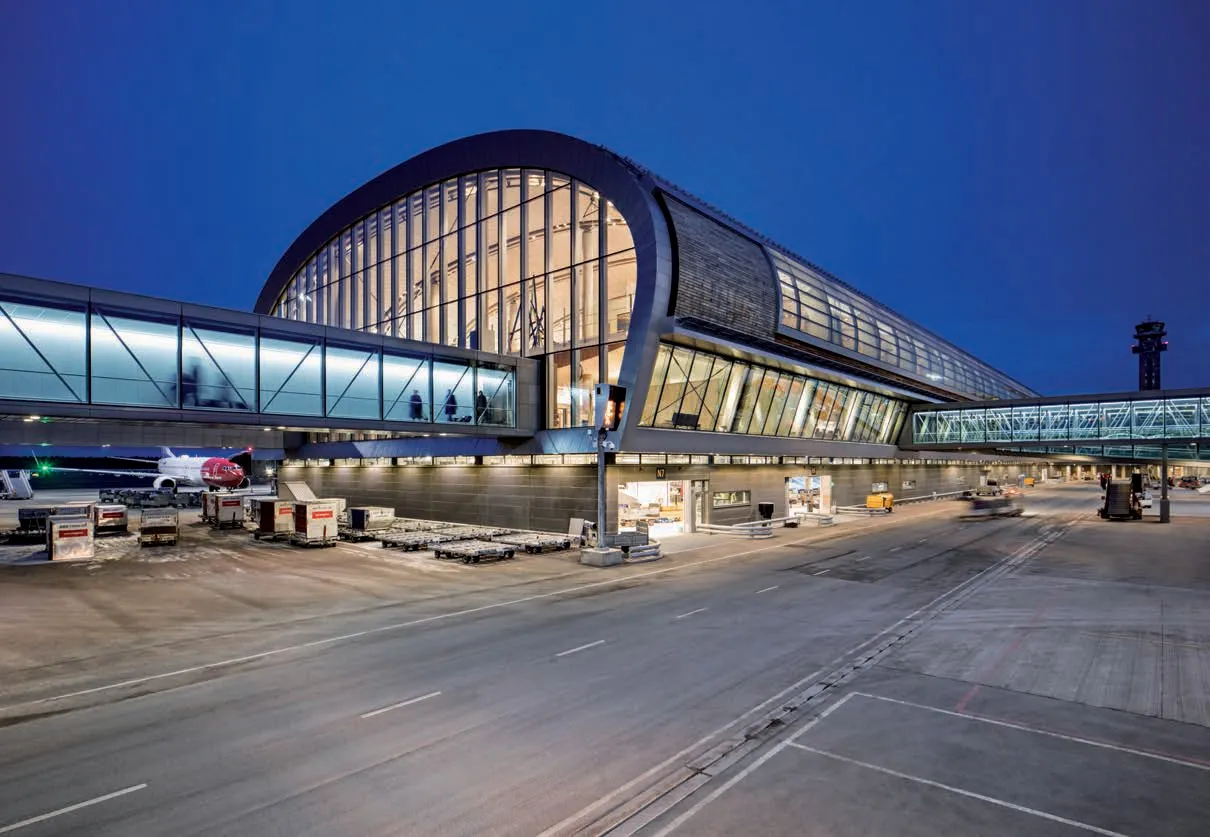
1
1 夜景/Night view
奥斯陆机场扩建项目已成为斯堪的纳维亚设计的精湛典范。该项目是世界上第一个达到英国建筑研究院环境评估方法(BREEAM)优秀等级的机场,距离获得最高的卓越等级认证仅一步之遥。媒体称赞其为未来机场的蓝图和世界上最环保的机场。
扩建包括了面积为52,000m2的出发大厅和抵达大厅的延伸、63,000m2的新建北侧指廊及扩建的火车站——其总和几乎使得原航站楼面积翻倍。扩建还包括了新的能源中心、新的陆侧基础建设和空侧的延伸和新增设施。项目使得机场吞吐量从每年1900 万增加至3200 万人次,并有望增加至3600 万人次。
作为整体可持续策略的一部分,机场与奥斯陆市中心的连通率可达70%。旅客最集中的抵达方式是乘坐每小时10 班次的火车。和欧洲各大机场相比是最高水平。建设过程中,机场和火车站均保持全面运行状态。
现存结构启发而非限制了我们的想象。我们的目标是完善既有设计的表达,尤其考虑到材料运用、层级和尺度。通过在原有建筑上扩建,同时为未来引入新元素,项目在通用建筑语言的范围内,达成了这个目标。
新建的北指廊长300m,引入了全新的建筑表达——单曲面和双曲面外表皮。北指廊航站楼和中央航站楼一样,由胶合木结构和混凝土柱支撑。这些都塑造了机场的个性,同时具有前瞻性。
新建指廊在提供最大空间价值的同时拥有最小的外部围合表皮。通过国内和国际区域交错排布,达成最佳效率,确保旅客可使用所有登机门,使得建筑的占地面积显著减少。建筑的外形可充分利用被动太阳能及日照,应用区域供暖和自然热能等特色低碳技术。
贯穿设计阶段的一项关键要求是通过测试和记录的方式进行建筑材料的审批。新建指廊采用了兼具功能、美学和环境需求的橡木饰面。外立面玻璃的大面积使用,为观赏周围自然环境和变化的自然光线提供了视野,创造出时间感和场所感,利用被动太阳能的同时,减少日间人工照明的需求。
地面热源技术的使用,可为机场提供热能;机场雪库存放的积雪可用作夏季冷却剂,项目对能源的需求将显著降低。提升的保温性能和低空气渗透率,使该项目达到被动房屋能源性能的典范性标准。
天然热能的利用是扩建项目的可持续性策略的关键部分。大型雪库保存了冬季从机场周边活动区收集的积雪,用于航站楼的夏季制冷。该措施替代了约5MW 的冷却设备能源,每年可节能2GW·h。其他低碳技术,如相邻市政废水净化蓄热、能量井、地下水蓄能和热泵技术利用,均为节约与再利用能源所采取措施的范例。(王欣欣 译)
The Oslo Airport Expansion has become an example of Scandinavian design at its best. It is the first airport in the world to achieve a BREEAM Excellent rating, only narrowly missing the highest possible rating: Outstanding. It has been hailed by media as the blueprint for future airports and the greenest airport in the world.
The expansion comprises of a 52,000m² extension of the departures and arrivals hall, a 63,000m² new northern pier and an expanded rail station - in total nearly doubling the size of the original terminal building. The expansion also included a new energy central, new landside infrastructure and airside extensions and facilities. It has increased the airport's capacity from 19 to 32 million passengers per year, with a further potential increase to 36 million.
As part of a holistic sustainability approach, the airport has 70% public transport connectivity to Oslo city centre; the vast majority arriving by one of the 10 trains per hour serving the airport. This is the highest percentage for any major airport in Europe. During construction, both the airport and rail station remained fully operational.
The existing structure has inspired, not inhibited our thinking, or restricted our ideas. The goal was to complement the existing design expression, especially considering material use, hierarchy and scale. The expansion achieves this by building on the original architecture, while introducing new elements for the future, all within a common architectural language.
The 300-metre long new northern pier features a brand-new architectural expression with both curved and double curved surfaces. The pier is, like the central building, held up by a glulam structure and concrete columns. It all contributes to the identity of the airport, while at the same time pointing to the future.
The curved form of the new pier provides maximum spatial value whilst having a minimal external envelope. Optimal efficiency is achieved by stacking the domestic and international zones in the pier - enabling all travellers to use all gates and giving the building a signif icantly smaller footprint. The shape of the building takes advantage of passive solar energy and sunlight, and features low-carbon technologies like district heating and natural thermal energy.
A key requirement throughout the design phase was the approval of building materials by testing and documentation. The new pier is clad in oak timber to combine functional, aesthetical and environmental demands. The extensive use of glass in the façades provides views to the surrounding nature and changing natural light, creating a sense of time and place, while simultaneously taking advantage of passive solar energy and reducing the need for artif icial light in daytime.
Energy requirements will be extremely low due to the use of ground source heat technology to provide heating and the use of snow from the airport's snow storage depot as a coolant during summer. The enhanced levels of insulation and low air infiltration enable exemplary Passive House energy performance standards.
Utilising natural thermal energy was one of the key elements in the sustainability strategy for the new extension. A large snow depot preserves snow collected from airside areas during winter to provide cooling in the terminal during summer. This replaces approximately 5MW of energy from the cooling plants and represents an annual energy reduction of about 2GWh. Other low-carbon technologies such as heat retention through purified wastewater from the adjacent municipality, energy wells, ground water energy conservation and utilisation of heat pump technology, are all examples of measures implemented to save and reuse energy.
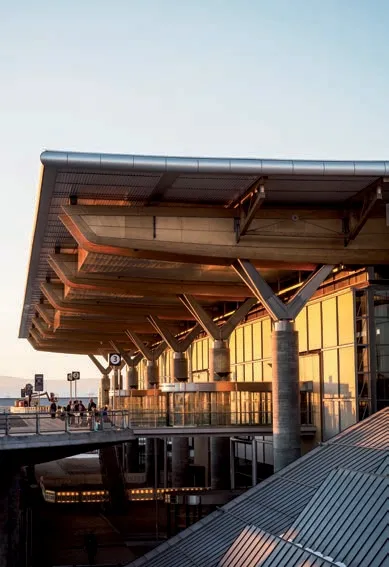
2

3
2 出发前厅/Departure forecourt
3 出发大厅/Departure hall

4
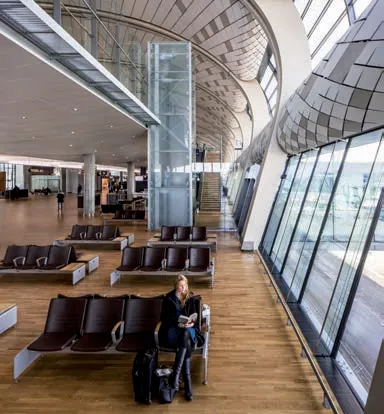
5
4 F层平面/Plan F
5 出发旅客候机区/Departure passenger waiting area
项目信息/Credits and Data
客户/Client: Oslo Lufthavn
主持建筑师/Principal Architect: Gudmund Stokke
设计团队/Design Team: Christian Henriksen, Bjørn Olav Susæg, Eskild Andersen, Roald Sand, Astrid BuggeFrøvig, Christian von der Leyen, Christine Obmascher, Liv Aimee Halvorsen, Cornelia Fischer, Daniela Cardoso Tunheim, Erik Fonne, Erik Urheim, Tom Holtmann, Mari Dokken Bjørge, Francois Chevalier, Morten M. Ræder, GergelyJaszay, Håkon Follesø, Ingrid Motzfeldt, Imola Kinga, Ivar Ivarsøy, John Philip Clark, Jørund Johansen, Michael Jankowski, Michael Olofsson, Soren Shen-Lung Lin, Julie Gedde-Dahl, Tormod Slevikmoen, Anders Doser, Peter Dang, Christina Walstad, Knut Ramstad, Ole Tørklep
合作单位/Partners: Nordic-Office of Architecture (leading office), COWI, Norconsult, Aas-Jakobsen, Per Rasmussen
项目顾问/Sub-Consultants: HSW, Hjellnes Consult, Bjørbekk & Lindheim Bjørbekk Landskapsarkitekter, Speirs + Major, BuroHappold Engineering, AKT II
建设公司/Construction Company: Avinor Oslo Lufthavn
服务范围/Scope: 机场规划设计,总体规划,可持续设计,视觉设计,BIM设计,室内设计,家具设计,产品设计,设计管理/Airport planning and design, master planning, sustainability, visual group, BIM, interior design, furniture design, product design, design management
建筑面积/Architectural Area: 航站楼建筑面积/Terminal architectural area: 140,000m2; 总平面/Master plan: 13.5km2; 35,000,000旅客年吞吐量/35 MPA
成本/Cost: 14B NOK
设计时间/Design Period: 2009-2017
竣工时间/Completion Time: 2017.04.27
摄影/Photos: Ivan Brodey (fig.1,3,5,11,12), Dag Spant (fig.2), Knut Ramstad (fig.9,10)
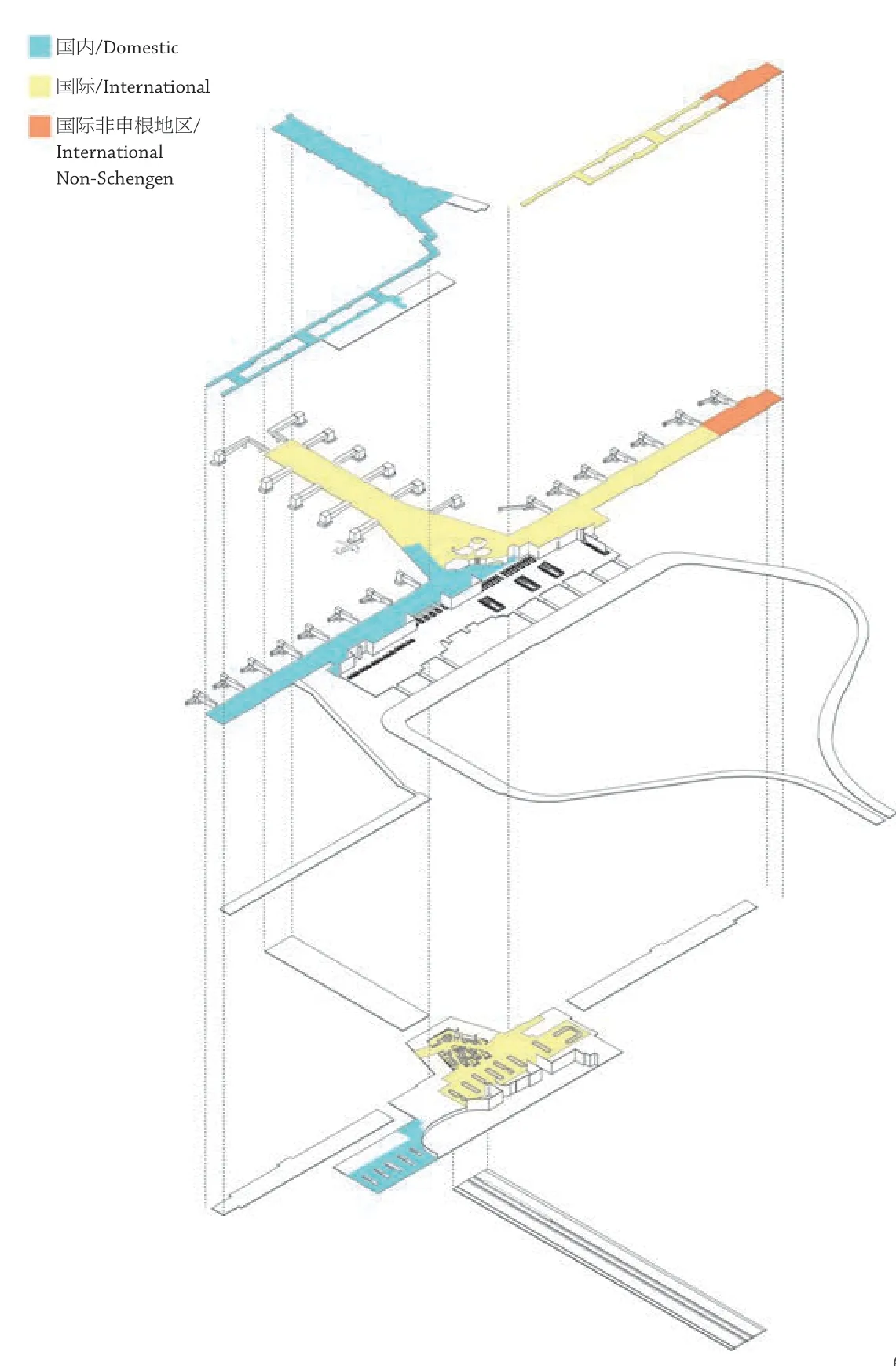
6
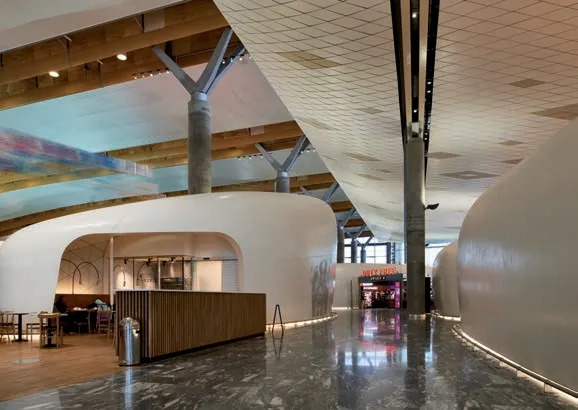
9
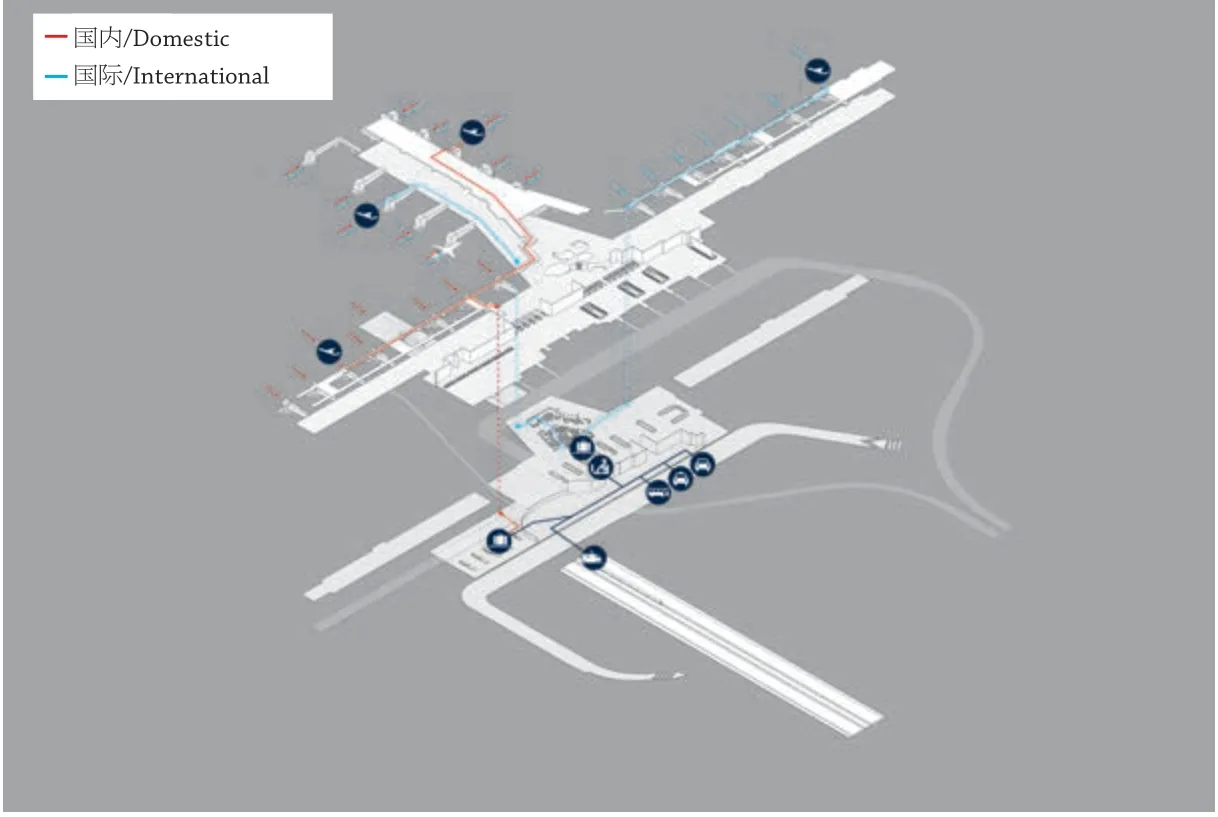

7
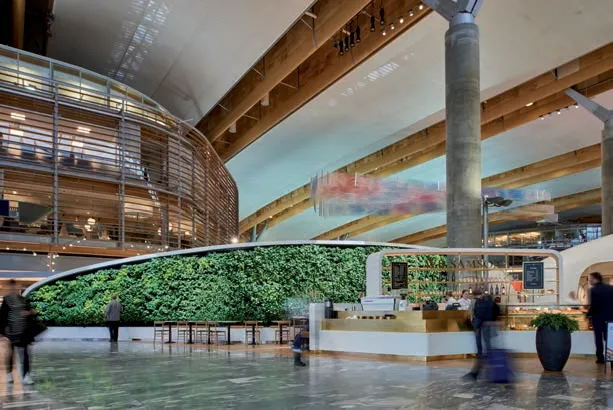
10
6 分区/Division
7 旅客到达流线/Passanger journey - Arrivals
8 旅客出发流线/Passanger journey - Departure
9 商业内景/Interior commercial pods
10 内景/Interior view

11
11 出发大厅/Departure hall
评论
易田:奥斯陆机场扩建项目充分体现了建筑可持续发展的要义,很难想象在北欧极寒地带可以实现拥有如此规模玻璃幕墙的航站楼建筑,其对天然能源的存储与利用值得长足借鉴。航站楼占地非常集约,作为交通建筑的使用效率非常高,展现了建筑师对建筑功能性的深刻理解。航站楼的外形并不复杂,空间上通过V 柱形成的广厅空间与波浪漫射吊顶形成的低矮空间做对比,创造了空间的节奏感。建筑材料上也尽力还原展示材料的天然性,体现混凝土、木材、石材等材料的本貌。
阳旭:奥斯陆航站楼主体呈三指廊构型,构型使得主要旅客的步行距离呈现均好性,得到了控制; B指廊与航站楼主体通过通道步行可达而不是设置近端卫星厅,可以减少摆渡车的使用;楼内广泛使用木材或木质饰面,回收钢材和与火山灰混合的特殊环保混凝土也得到了大量使用,与北欧当地地域特征相契合。整座航站楼广泛采用生态节能技术,将其塑造成为可持续发展的典范。
Comments
YI Tian: Oslo Airport Expansion fully expressed the essence of sustainable architecture. It is hard to imagine the realisation of a terminal building with such large extent of glass curtain walls in Scandinavia's extremely cold climate region. The storage and utilisation of natural energy in this project is especially worth learning. The terminal building has a compact footprint. As a transportation building, its utilisation efficiency is significantly high. Apparently the architects have very deep understanding towards the functionality of architecture. The form of the terminal building is not complicated. A spatial rhythm is formed by the contrast between the grand space supported by V-shaped columns and the light-diffusing low wavy ceilings. In terms of materiality, the architects tried their best to reveal the natural appearance of the materials used, including concrete, wood and stone. (Translated by WANG Xinxin)
YANG Xu: The main body of Oslo Airport Terminal is in a three-finger pier configuration which makes the walking distance of most of passengers equal and controlled. B airside concourse is connected to the terminal through the passengers' available channel instead of setting up the proximal satellite hall, which can reduce the use of ferries. The extensive use of wood or wood finishes, and special environment-friendly concrete mixed by recycled steel and volcanic ash, are in keeping with the geographical characteristics of Scandinavia. The whole terminal adopts ecological energy-saving technology broadly, shaping it the exemplar of terminals of sustainable development. (Translated by PANG Lingbo)

12
12 商业内景/Interior commercial pods
